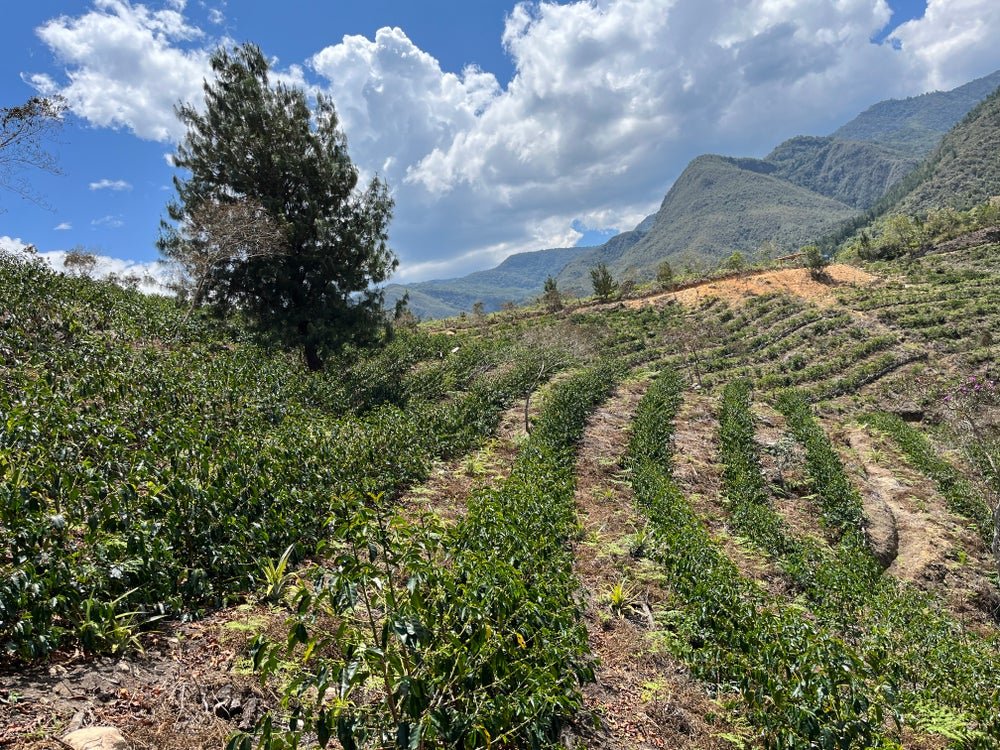Luke 4
Prosperidad de Chirinos
COUNTRY: Peru
FARM/COOP/STATION: Cooperativa La Prosperidad de Chirinos
VARIETAL: Bourbon, Catimor, Catuai, Caturra, Marsellesa, Mundo Novo, Pache, Typica
PROCESSING: Fully washed
ALTITUDE: 1,200 to 1,900 meters above sea level
OWNER: 817 producers with Prosperidad de Chirinos
SUBREGION/TOWN: San Ignacio
REGION: Cajamarca
FLAVOUR NOTES: Green apple, hazelnut, white flowers, yellow pear, hints of milk chocolate and brown sugar
ABOUT THE PRODUCER
Prosperidad de Chirinos was founded in 1968. Today, they have 817 members, a full quarter of whom are women. In total, the cooperative cultivates about 2,200 hectares in San Ignacio, Cajamarca. The high altitudes of the mountainous San Ignacio region provide ideal conditions for cultivating high-quality coffees.
The cooperative has an extensive array of programs and opportunities for farming members. In addition to agronomic support and financing, farmers can learn sensory evaluation and how to diversify their incomes through other agricultural projects such as beekeeping and farming avocadoes. They also offer quality awards for outstanding coffees each year. Managers and farmer-leaders are given additional training in management skills, financial literacy and good governance.
Over a quarter of Prosperidad de Chirinos’ members are women, who are typically underserved and under-represented in the coffee-producing sector. The cooperative aims to address this imbalance with a women’s committee that promotes empowerment for female members. Many members in the committee have taken on additional managerial positions.
There is also a youth committee that is focused on supporting and empowering young producers. A partnership with the National University of Jaén supports university education for 10 children of cooperative members each year.
HARVEST
Farmers in Peru usually process their coffee on their own farms using the Fully washed method. Cherry is usually pulped, fermented and dried in the sun. Traditionally, smaller farmers would use tarps laid on the ground or under the roof of their homes. Increasingly, cooperatives are establishing centralized drying facilities – usually raised beds or drying sheds where members are encouraged to dry their parchment. Some farmers are beginning to adopt these practices on their own farms, and drying greenhouses and parabolic beds are becoming more common as farmers pivot towards specialty markets.
After drying, coffee will then be sold in parchment to the cooperative. Producers who are not members of a cooperative often have the opportunity to sell on to cooperatives, as well.
CULTIVATION
Members receive agronomic support, training in Good Agricultural Practices and access to financing through Prosperidad de Chirinos.
The cooperative has a demonstration plot in San Ignacio where farmers can learn about agronomic practices and how to implement them. They learn about fertilization techniques, pest management and best harvesting practices.
COFFEE IN PERU
Peru holds exceptional promise as a producer of high-quality coffees. The country is the largest exporter of organic Arabica coffee globally. With extremely high altitudes and fertile soils, the country’s smallholder farmers also produce some stunning specialty coffees.
Though coffee arrived in Peru in the 1700s, very little coffee was exported until the late 1800s. Until that point, most coffee produced in Peru was consumed locally. When coffee leaf rust hit Indonesia in the late 1800s, a country central to European coffee imports at the time, Europeans began searching elsewhere for their fix. Peru was a perfect option.
Between the late 1800s and the first World War, European interests invested significant resources into coffee production in Peru. However, with the advent of the two World Wars, England and other European powers became weakened and took a less colonialist perspective. When the British and other European land owners left, their land was purchased by the government and redistributed to locals. The Peruvian government repurchased the 2 million hectares previously granted to England and distributed the lands to thousands of local farmers. Many of these farmers later grew coffee on the lands they received.
Today, Peruvian coffee growers are overwhelmingly small scale. Farmers in Peru usually process their coffee on their own farms. Most coffee is Fully washed. Cherry is usually pulped, fermented and dried in the sun on raised beds or drying sheds. Drying greenhouses and parabolic beds are becoming more common as farmers pivot towards specialty markets.
After drying, coffee will then be sold in parchment to the cooperative. Producers who are not members of a cooperative will usually sell to a middleman.
The remoteness of farms combined with their small size means that producers need either middlemen or cooperatives to help get their coffee to market. Cooperative membership protects farmers greatly from exploitation and can make a huge difference to income from coffee. Nonetheless, currently only around 15-25% of smallholder farmers have joined a coop group.














